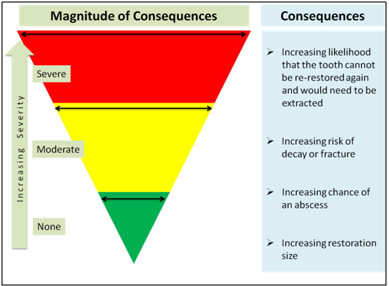A dental restoration is a filling or crown (cap) that restores the part of a tooth that has been irreversibly damaged by tooth decay or lost as a result of fracture. While a dental restoration is a way to get rid of decay, it may not reduce the risk for tooth decay. In fact, the seam between the dental restoration and the tooth is a risk factor for tooth decay because bacteria can grow in it.

The larger the cavity or more severe the fracture the more complicated it is to repair a tooth back to a normal condition. One consequence of severe decay or fracture, because it extends deeply into the center of a tooth, is an abscess. An abscess is frequently very painful and occasionally can spread deeper into the body creating a very serious health condition that requires advanced medical care and possibly hospitalization. Another consequence is too little remaining tooth for a filling or crown. Extraction of a tooth is not always needed when any of these complications occur. Dental treatment that may “save” the tooth includes a root canal and exposure of a portion of the tooth currently covered by gum tissue.

Unfortunately a dental restoration may not last forever although it could last 10, 20 or more years. And every time a new dental restoration is done less of the natural tooth remains. Subsequent decay or fractures added to the original loss of tooth structure may result in too little remaining tooth for a new dental restoration. As described above, when too little tooth remains common options are extraction or surgery to expose of more tooth structure. If a tooth is extracted there are several options to fill in the missing space including implants and bridges.